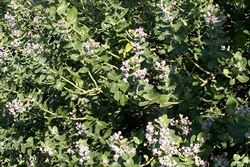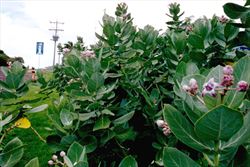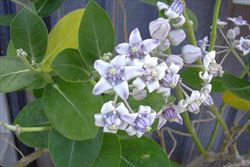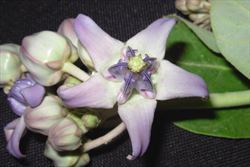Click on images to enlarge

habit (Photo: Chris Gardiner)

habit (Photo: Land Protection, QDNRW)

large leaves and flower clusters (Photo: Chris Gardiner)

whitish-coloured younger leaves (Photo: Chris Gardiner)

flower cluster (Photo: Forest and Kim Starr, USGS)

close-up of flower buds (Photo: Land Protection, QDNRW)

flowers (Photo: Steve Adkins)

close-up of flower (Photo: Chris Gardiner)
Scientific Name
Calotropis gigantea (L.) Ait.
Synonyms
Asclepias gigantea L.
Family
Asclepiadaceae (the ACT, Victoria, Tasmania, South Australia, Western Australia and the Northern Territory)Apocynaceae (Queensland and New South Wales)
Common Names
bowstring hemp, calotrope, crownplant, giant calotrope, giant milkweed, giant rubber bush
Origin
Native to Iran, the Indian Sub-continent (i.e. India, Nepal, Pakistan and Sri Lanka), China and south-eastern Asia (i.e. Laos, Myanmar, Thailand, Indonesia and Malaysia).
Naturalised Distribution
Naturalised in northern Queensland, northern Western Australia and the northern parts of the Northern Territory.
Notes
This introduced shrub with milky sap is frequently cultivated as a garden plant (i.e. ornamental) in the tropical parts of northern Australia. It has become naturalised in drier tropical regions and in sandy coastal habitats and may be very easily confused with the more widespread and more significant environmental weed known as calotrope (Calotropis procera ).
Giant calotrope (Calotropis gigantea) may cause problems comparable to this species and has potential to invade degraded rangeland pastures, river flats and coastal dunes. For example, it is one of many ornamental species that is invasive along the sandy beachfronts of Far North Queensland.

